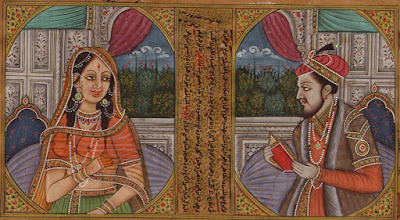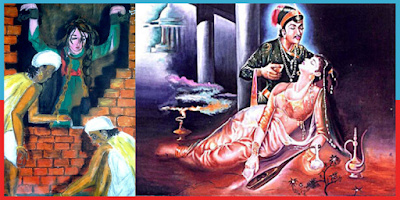Why do we say that Jahangir caused much heartache to his father, Akbar the Great?
Jahangir was the eldest son of Akbar. the Great. His real name was Muhammad Sultan Salim. He was born on Wednesday, September 9, 1569, after many prayers and blessings to the saints.
However, prince Salim caused much heartache to Akbar during the last years of Akbar's life. He felt that Akbar had been the Emperor too long, and, when Akbar was away from the capital on an expedition, Salim broke into an open rebellion, and declared himself Emperor. Akbar hastily called his trusted general, Abul Fazl to deal with his troublesome son.
Do you know what Sallm did then?
He had Abul Fazl assassinated, and sent his head to the emperor! Akbar was naturally very angry. It was only when his mother and other ladies of the court pleaded with him, that he forgave his son.Akbar died in October, 1605, and Salim ascended the throne to become the Emperor.
Why did Jahangir blind his elder son, Khusrau?
Prince Khusrau was the eldest son of Jahangir. When he was eighteen, Khusrau rebelled against his father. He slipped out of Agra at night and went to Kabul, picking up many supporters on the way. Jahangir chased him, and within three weeks, Khusrau was captured.
He stood before the emperor, trembling and weeping. His father made him watch 300 of his supporters being killed brutally and then threw him in jail.
Even when he was in jail, Khusrau continued to plot against his father. When Jahangir learnt of this, he was furious. He had Khusrau blinded, according to Jahangir, he should have killed his son, but it was only because of his affection for him that he had him blinded!
Why did Jahangir install a ‘chain of justice'?

Jahangir was determined that his subjects should receive justice without interference from his officials. So, he installed his famous ‘chain of justice'. It was a golden chain attached to sixty bells, which was hung outside his palace. Anyone who was in trouble or needed help could pull the chain and would be given a personal hearing by the emperor or himself. The chain of justice was an important link between the Emperor and his subjects. It played an important role in building up Jahangir's reputation as a just ruler, who cared deeply for his people.
What was Jahangir's approach to religious issues?
Emperor Jahangir readopted Islam as the state religion, reversing the Din-i-llahi of Akbar. But, he continued the policy of religious tolerance. His court included large numbers of Indian Hindus, Persian Shias and Sufis, and members of local Islamic sects. He even banned cow slaughter to please the Hindus!
Personally, however, he adopted whatever religious practices were convenient for him. He visited both Hindu and Muslim mystics, and he was also a disciple of the Chishti saint Muin al-Din. It must be said that he enjoyed having disciples of his own too!
Why do we say that Nur Jahan was a major influence in Jahangir's life?

Nur Jahan was one of the most influential women of her day. She was the favorite wife of the powerful Mughal emperor Jahangir, and she played an important role in the administration, politics, and economics of the empire.
At the time of her marriage, Nur Jahan was the widow of a man who had lost favor with the emperor. Yet, within nine years Nur Jahan became as powerful as the emperor himself. The key to her success was the emperor's adoration of Nur Jahan above everyone else. Jahangir needed Nur to help maintain his health and help him rule.
STAR FACT
Emperor's Favourites
Jahangir chose his favourite courtiers to become royal disciples. This was seen as a great honour.At a special ceremony, each one was given a tiny gold locket with the portrait of the emperor, hanging from a gold chain. It became fashionable for the disciples to wear pearl earrings in each ear as their emperor did.
Nur Jahan approved all orders and grants of appointment in Jahangir's name and controlled all promotions and demotions within the royal government. She took a special interest in the affairs of women, giving them land, and dowries for orphan girls. She had coins struck in her name, collected duties on goods from merchants who passed through the kingdom, and traded with Europeans who brought luxury goods from the continent.
Nur Jahan experimented with new perfumes, hair ointments, jewelry, silks, brocades, porcelain, and cuisine from other lands. She wrote poetry and was a patron of all the arts. She created many exquisite gardens and built many architectural masterpieces.
Why did Mughal painting flourish under Jahangir?

Jahangir was a great patron of painting. He patronized many great painters of the time including Mansur, Abul Hasan, Daswant, and Basawan. The main themes of the Mughal paintings of this time revolved around the events from Jahangir's own life. One of the most popular examples of Mughal paintings of this time included the illustrations of the Jahangir Nama, the biography of Emperor Jahangir. Jahangir's liking for painting was so strong that he was able to judge which painter had executed which work. Moreover, if there was a picture containing many portraits drawn by different artists, Jahangir was able to identify the artists from the stroke of the brushes.
Why did Shah Jahan rebel against Jahangir?

Shah Jahan was Jehangir's third son. His real name was Prince Khurram, and in 1622, Jahangir ordered him, to lead the Mughal army against Afghanistan.
Khurram, however, had other plans. He knew that his father was weak and addicted to alcohol and drugs and that the Empress Nur Jahan was plotting against him. So, he was unwilling to leave Delhi and delayed his departure giving one excuse after the other. Nur Jahan viewed his delays as rebellion and managed to persuade Jehangir of this as well.
Finally, Khurram's army was forced to march, but instead of going to Afghanistan, Khurram headed for Agra and tried unsuccessfully to seize the city of Fatehpur Sikri. He was defeated and forced to retreat. Finally, Khurram's army was exhausted, and he had no choice but to surrender. His rebellion against his father was at an end.
What was the Age of Expansion?
We know that Babur founded the Mughal Empire, and it grew under his son Humayun, and later, under Akbar too. The last of the three Great Mughals Jahangir, Shah Jahan, and Aurangzeb made the empire even mightier. This was known as the 'Age of Expansion'. Aurangzeb expanded the empire to include nearly the entire subcontinent, but he could never totally subdue the Marathas of the Deccan, who resisted him until his death. After his death, his three sons fought over the succession, and the Mughal empire crumbled, just as the Europeans were growing stronger in India.
Why is Anarkali famous?

Anarkali was only a slave girl in Akbar's court, yet her story touched the hearts of millions all over the world. Do you know why? It is because the story of Anarkali and Prince Salim who later became emperor Jehangir, is one of the greatest romances of all time. Anarkali and the prince were in love, when the emperor Akbar came to know about it, he was furious. He ordered Anarkali to be buried alive, a wall was built around her and she was trapped inside. Prince Salim could not save her, but by dying, Anarkali remains alive in the hearts of lovers everywhere.
Why is the tomb of Itimad ud Daulah called a jewel box?

The Itimad ud Daulah tomb houses the body of Mirza Ghiyas Beg, the father of Mughal empress Nur Jahan, who was emperor Jahangir's wife. It is the first example of a tomb built on a riverbank in India and is situated on the banks of the Yamuna. It is a domed structure complete with a formal garden, waterways, and paths laid out in a geometrical pattern. The tomb is built in pure marble, and the carvings on this monument are said to be even better than that of the Taj Mahal. The walls of white marble from Rajasthan are encrusted with semi-precious stone decorations formed into images of cypress trees and wine bottles, or more elaborate decorations like cut fruit or vases containing bouquets. Light penetrates to the interior through delicate, intricately carved screens. Is it any wonder that it is often described as a jewel box in marble?
